Module 3 Intro
| Site: | MoodleHUB.ca 🍁 |
| Course: | Biology 20 SS |
| Book: | Module 3 Intro |
| Printed by: | Guest user |
| Date: | Wednesday, 24 December 2025, 4:47 AM |
Description
Created by IMSreader
Table of contents
- 1. Module 3 Intro
- 1.1. Big Picture
- 1.2. In this Module
- 1.3. Lesson 1 Intro
- 1.4. Page 2
- 1.5. Page 3
- 1.6. Lab
- 1.7. Page 5
- 1.8. Page 6
- 1.9. Page 7
- 1.10. Lesson 2 Intro
- 1.11. Page 2
- 1.12. Page 3
- 1.13. Page 4
- 1.14. Page 5
- 1.15. Lesson 3 Intro
- 1.16. Page 2
- 1.17. Page 3
- 1.18. Page 4
- 1.19. Lesson 4 Intro
- 1.20. Page 2
- 1.21. Page 3
- 1.22. Page 4
- 1.23. Page 5
- 1.24. Lesson 5 Intro
- 1.25. Page 2
- 1.26. Page 3
- 1.27. Page 4
- 1.28. Page 5
- 1.29. Page 6
- 1.30. Lesson 6 Intro
- 1.31. Page 2
- 1.32. Page 3
- 1.33. Lab
- 1.34. Page 5
- 1.35. Page 6
- 1.36. Module Summary/Assessment
- 1.37. Module Glossary
1. Module 3 Intro
Module 3—Ecosystem Diversity
Module Introduction
In this module you will examine the components that make up ecosystems and how these components interact. This module builds on your knowledge of interactions of organisms within ecosystems from Unit A, and it draws on your knowledge of biological diversity from Science 7, 8, and 9.
If you have ever travelled even just a few hours from home, you will have experienced ecosystem diversity. There are many different ecosystems on the planet—rainforests, lakes, deserts, and grasslands. What makes each one unique?
In Unit A the focus was on the biosphere and specific ecosystems. You looked at how energy and matter move through the biosphere and through specific ecosystems. Abiotic and biotic factors contribute to the movement of energy and matter, and it was discussed how human influence can sometimes interfere with energy flow and biogeochemical cycles. Distinct ecosystems were introduced. In Unit B you will look at more specific details within an ecosystem. These details will help you define what makes an ecosystem unique, build upon what you know about interactions between species, and further explore the role of abiotic and biotic factors in an environment. Human impact will also continue to be explored. This all brings you back to answering the following questions:
- What makes an ecosystem distinct?
- How can you determine uniqueness?
- What can create changes in a distinct ecosystem?
- How can humans limit the impact of their activities?
By the end of this module you will have completed some activities to be marked by your teacher and others to help build confidence in your ability to understand, interpret, and express key course concepts. Everything should be saved in your course folder so that you are able to review pieces of information for exams, project work, or discussions. For example, you will need to complete a Parks Canada Ecological Integrity Advertisement as your module project, and you will need to use information gathered throughout this module. When you are ready to attempt the module project, you will find the project description and marking rubrics in the Module Summary.
1.1. Big Picture
Module 3
 Big Picture
Big Picture
Vacationing! Who wouldn’t want to take off somewhere on a vacation? When you think of going somewhere, it is usually somewhere far from where you live. The place you visit may also be quite different from your area in climate and scenery. The fun thing about vacations is that you get to see and experience new things.
You could fly to Mexico or drive to Banff. Both vacation destinations have unique environments that may be quite different from where you live. Many Albertans head to the Canadian Rockies for a holiday. So, what makes a beach resort in Mexico or a campsite in Banff National Park different from where you live?
If you think about it globally, there are thousands of places that are very different from your backyard. How would you decide whether a vacation spot has a different environment than the place where you live? What kind of observations would you have to make? As a vacationer, you must also consider the interactions you have with the surrounding environment. For a period of time, you are part of that ecosystem. How would you interact with other organisms? Maybe you haven’t thought of a vacation in this way before, but part of vacationing is appreciating the diversity that surrounds you (e.g., plants, weather, and animals).
As you work through this module, compare your backyard to the variety of ecosystems out there. Specifically, consider what identifies an ecosystem as being distinct.
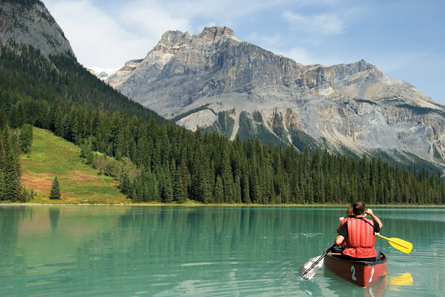
© Natalia Bratslavsky/Dreamstime
The following essential questions will be explored in Module 3:
- How do biologists explain the interrelationship of species, population, community, and ecosystem?
- How are organisms classified and named?
- How can observable characteristics be used to identify organisms at the genus species level?
- How do terrestrial and aquatic ecosystems support a diversity of organisms through a variety of habitats and niches?
- How do biotic and abiotic characteristics influence an aquatic and a terrestrial ecosystem?
- What are the effects of limiting factors on how and where an organism survives in an ecosystem? How do limiting factors influence the distribution and range of organisms?
- What can observations about biotic and abiotic factors gathered in a field study tell you about an ecosystem?
Throughout this module, you will work at developing an advertisement about ecological integrity as a module assignment. Do not begin creating this advertisement at this time. The various steps for completing this project will be explained in several lessons. Your advertisement will be submitted at the end of the module as the final module assessment. For detailed instructions and the evaluation criteria, visit the Module Assessment section.
1.2. In this Module
Module 3—Ecosystem Diversity
In This Module
Lesson 1—Populations, Communities, and Ecosystems
If you were asked about the community you live in, you would probably describe the people and buildings in your neighbourhood. How would you describe the community found in the natural environment? In this lesson you will define terms used to describe ecosystems and take a look at some relationships that exist within ecosystems.
- How do biologists describe the relationships that exist between species, populations, communities, and ecosystems?
Lesson 2—Classifying and Naming Organisms
Would a rose by any other name really smell so sweet? How was the rose’s scientific classification into the family Rosaceae decided? In this lesson you will examine the classification system used by scientists to organize and name all living things. The title of this lesson refers to a common mnemonic device used for remembering levels of classification.
- How are organisms classified and named?
Lesson 3—Classifying and Naming Organisms: Dichotomous Keys
In this lesson you will learn to use and create your own dichotomous key as a tool for classifying objects and organisms. By learning how to use a dichotomous key, you will be able to answer the following question.
- How can observable characteristics be used to identify organisms at the genus species level?
Lesson 4—Studying Organisms in Ecosystems: Biomes, Habitats, and Niches
Like organisms, ecosystems are made up of specific parts. Each part depends on the interaction of biotic and abiotic factors. This lesson will explore biomes, habitats, and niches and will look at how each one is dependent on different abiotic and biotic factors.
- How do terrestrial and aquatic ecosystems support a diversity of organisms through a variety of habitats and niches?
- How do biotic and abiotic characteristics influence an aquatic and a terrestrial ecosystem?
Lesson 5—Studying Organisms in Ecosystems: Limiting Factors
When you compare a tropical rainforest with the northern tundra, you likely assume correctly that more organisms are found in a tropical rainforest. Organisms are not evenly distributed across Earth’s surface. Their distribution is due to limiting factors that you will explore in this lesson.
- How do limiting factors influence the distribution and range of organisms?
Lesson 6—Studying Organisms in Ecosystems: A Field Study
Finally, you get to go on a field trip.
- What can observations of biotic and abiotic factors gathered in a field study tell you about an ecosystem?
1.3. Lesson 1 Intro
Module 3—Ecosystems and Their Diversity
Lesson 1—Populations, Communities, and Ecosystems
 Get Focused
Get Focused
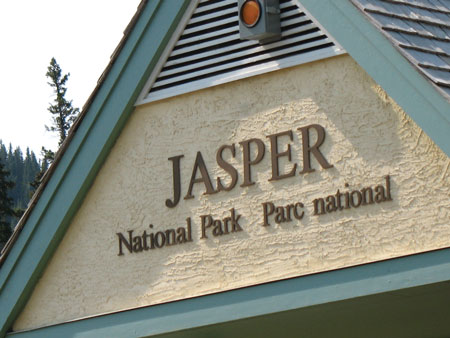
Courtesy John Lawford
You have opted for an adventure vacation in a national park nestled in the great Canadian Rockies. As you enter the national park, you are required to slow down due to a speed limit change. And you notice signs telling you to be aware of animal crossings. Inside the park you see very few homes, restaurants, or large buildings. There is clearly no major development in this national park.
As you continue to drive, you become aware of the mountains, lakes, and forests around you. These areas provide diverse habitats for many types of organisms. You may see some of these organisms as you drive. You may wonder how these organisms interact with each other and with their biotic and abiotic environment. More importantly, as you explore this national park, you should consider how you may be affecting these organisms and their environment during your visit.
Consider the following question as you complete Lesson 1:
- How do biologists describe the relationships that exist between species, populations, communities, and ecosystems?
 Module 3: Lesson 1 Assignment
Module 3: Lesson 1 Assignment
Your teacher-marked Module 3: Lesson 1 Assignment requires you to submit a response to the following:
- Leaf Observation Lab Report
- TR 4. Wolves, Trees, and Elk
You can access your Module 3: Lesson 1 Assignment. You can print off the assignment or save the download to your computer. Your answers can be saved on this document to your course folder.
The other questions in this lesson are not marked by the teacher; however, you should still answer these questions. The Self-Check and Try This questions are placed in this lesson to help you review important information and build key concepts that may be applied in future lessons.
After a discussion with your teacher, you must decide what to do with the questions that are not part of your assignment. For example, you may decide to submit to your teacher the responses to Try This questions that are not marked. You may decide to record the answers to all the questions in the lesson and place those answers in your course folder.
The choices you make about responding to the Self-Check and Try This questions will depend upon your learning style, your abilities in this subject, and your goals for the course.
There are several types of questions in this lesson. For the Self-Check questions you can respond mentally, write out your response, or record your answer in any other way that works for you. There are Try This questions that will often be a part of your lesson assignment. These may require more attention and detail.
You will also be asked to complete labs virtually, on your own, or in a science lab. Lab reports will usually be used as a lesson assessment as well. At times, you will be asked to engage in discussion topics with other students. All hand-in assignments will be clearly indicated at the end of Get Focused and throughout the lesson. Not all questions/activities will be submitted to your teacher to be marked, but they do reinforce the key concepts you must learn to be successful.
Think of these questions/activities as little bits of Lego. You need to have many pieces of Lego before you can build a useful object. By the end of each module, you should have collected and stored enough Lego bits of knowledge to feel comfortable building ideas with them. If you are a few pieces short, you need to revisit a lesson.
As you work through Lesson 1, you need to decide if you will make your own notes, bookmark web pages for reference, draw diagrams/charts, or use other means to remember. You are in charge of how you learn. You can save everything in your course folder or, if you prefer paper, then attach your assignments, notes, and musings in a real binder. Don’t forget that some items MUST be put in the course folder.
1.4. Page 2
Module 3—Ecosystems and Their Diversity
 Explore
Explore
 Read
Read
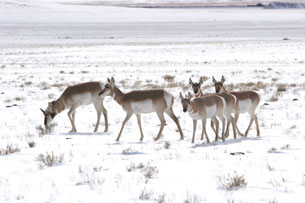
© Ed Endicott/shutterstock
If you had chosen to visit Cypress Hills Interprovincial Park, in southern Alberta, you would likely see a herd of pronghorn antelope. Pronghorn antelope are a species of animals that have been given the scientific name Antilocapra americana.
species: organisms that are similar in appearance and behaviour and are able to breed with one another to produce fertile offspring
population: a group of individuals of the same species living in a specific area at the same time
community: all the individuals in all the interacting populations in a given area
This group of antelopes shown in the photograph is referred to as a population because the animals were living together in an area of Waterton National Park at the time the photograph was taken. Within Waterton National Park there are populations of different animals. These populations are not isolated and will interact with each other. These populations that interact form a community.
 Self-Check
Self-Check
SC 1. What other populations would be interacting with this population of antelopes?
 Self-Check Answer
Self-Check Answer
SC 1. Some populations that would interact with this population of antelopes are populations of grasses, bears, and white-tailed deer.
biotic: living
abiotic: non-living
The biotic components of the antelopes’ environment include all of the populations of plants and animals in the same environment. The term biotic refers to all of the living components of the environment. Some abiotic components of the antelopes’ environment include the climate, water, sunlight, minerals, rocks, and soil—the non-living components.
 Try This
Try This
TR 1. Watch an animation showing the interaction of animals and plants with the living and non-living components of the ecosystem. Make a list of the following items:
- all the biotic components
- all the abiotic components
- an example of an interaction between an abiotic and a biotic component
Put your findings into your course folder for future reference.
1.5. Page 3
Module 3—Ecosystems and Their Diversity
 Read
Read

ecosystem: a community of populations together with the abiotic factors that surround and affect the ecosystem
biosphere: all the areas on Earth that are inhabited by life
biodiversity: the variety of species in an area and their range of behavioural, ecological, physiological, and other adaptations
All of the biotic and abiotic components in the environment make up an ecosystem; and all the ecosystems in the world and their interactions make up the biosphere. Living organisms are found high in the atmosphere, deep in the ocean, and below the soil layer. This area on Earth where living organisms are found is called the biosphere. The term biodiversity refers to the variety of different species of organisms and ecosystems that exist in an area.
Read from “Organisms and Their Environment,” on page 78 of the textbook, to the end of “The Bigger Picture: Earth’s Biosphere,” on page 83. You can skim over “Investigation 3A” and “Thought Lab 3.1”; however, these parts of the textbook will be revisited later on in the unit.
 Try This
Try This
TR 2. Read Parks Canada’s article “The wolf has a story to tell,” and think about how different populations interact with the wolf population. After you read the article, complete the Wolf Article Self-Test.
TR 3. What are some of the problems that could potentially be caused by the wolf-willow population interaction? With a partner, make a list of some problems that could occur if the wolf and willow populations were too large or too small. Share your list with other students.
 Watch and Listen
Watch and Listen
The podcast titled “Wolves, Trees, and Elk” explains how the reintroduction of wolves to Yellowstone National Park has helped the aspen tree population recover in certain areas. Listen to the podcast and read the transcript of the interview with Bill Ripple. Use this information to complete the first part of your Module 3: Lesson 1 Assignment.
To access this podcast, type the following keywords into a websearch engine: “wolves,” “trees,” “elk,” “earth,” and “sky.” This is Program #4159 of the Earth & Sky Radio Series. A transcript of the podcast is available. You may choose to just listen to the podcast or read the transcript. Or you can both listen to and read the podcast. If you are unsuccessful in finding this podcast, the key words “wolves,” “trees,” “elk,” and “Yellowstone national park” will lead you to several articles discussing the same topic. If necessary, these articles will also help you complete your assignment.
 Try This
Try This
TR 4. Wolves, Trees, and Elk
Go to your Module 3: Lesson 1 Assignment to complete the activity associated with Watch and Listen.
1.6. Lab
Module 3—Ecosystems and Their Diversity
 Read
Read
Interactions between organisms influence how a community is structured. Some possible interactions found in a community are
- competition between individuals of the same species (intraspecific competition)
Example: two elk fighting
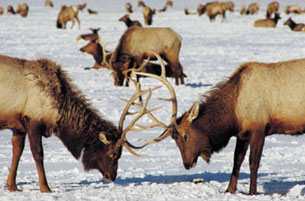
Courtesy of U.S. Dept of the Interior, Bureau of Land Management
- competition between individuals of different species (interspecific competition)
Example: different species of African animals competing for water

© 2007 Jupiterimages Corporation
- predator and prey relationships
Example: wolves hunting elk
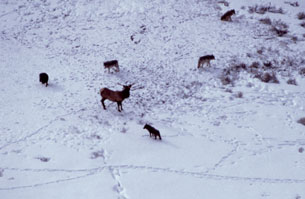
Courtesy of U.S. National Park Service
-
populations interacting with abiotic factors
Example: trout in water vs. bison on land
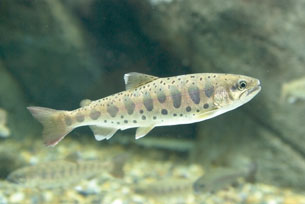
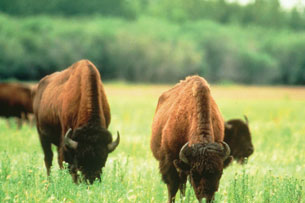
Fish: © Ilya D. Gridnev/shutterstock
Buffalo: © Image courtesy of Syncrude Canada Inc.
All of these interactions are dynamic—they are constantly changing. An area that was once suitable for trees can be made unsuitable by fire, rockslides, or a variety of other disturbances. The new habitat created by these disturbances may be less suitable for trees but will be more suitable to other species, such as moss and lichens. Over time, the moss and lichens can change the habitat so that it once again becomes suitable for shrubs and grasses to grow.
The following graph shows how the types of species change as time passes. The graph describes a habitat recently exposed by a melting glacier.
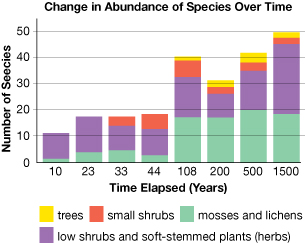
 Self-Check
Self-Check
SC 2. Why does it take over 100 years for trees to appear in this habitat?
SC 3. Before you continue, think of some abiotic conditions that could influence the size of leaves on a plant.
 Self-Check Answer
Self-Check Answer
SC 2. It takes a long time for the nutrients in the soil to build up so that they could supply enough nutrients to the extensive root system of a tree.
SC 3.
- amount of moisture
- amount of nutrients in soil
- amount of available sunlight
1.7. Page 5
Module 3—Ecosystems and Their Diversity
 Lab: Leaf Size
Lab: Leaf Size
Use the information from this lab to complete your Module 3: Lesson 1 Assignment.
morphology: the form and structure of an organism or any of its parts
Abiotic conditions in the environment affect biotic components in the environment. You will examine the effects of different abiotic conditions on the morphology of plant leaves. The leaves on plants in two different locations with different abiotic conditions will be studied.
You will have two options to complete this lab—by conducting an outdoor lab to collect data or by completing a lab simulation. You may choose to do the simulation if the trees in your area currently do not have leaves. The season and or your preference may be the deciding factor.
You may also choose to do both lab options and compare the results and experiences. Both labs will require the collection of data and completion of the questions in Module 3: Lesson 1 Assignment.
Purpose
The purpose of this lab is to determine if different abiotic conditions affect a plant’s morphology.
Materials for Outdoor Lab Option
If the season permits and leaves are measurable on the trees, you will need a ruler, a chart for recording your data, and access to plants of the same species in two different areas.
Materials for Simulation Lab Option
If the season does not permit for outdoor lab work, you will use the simulation to complete you lab. You will need a chart for recording your data.
Procedure for Outdoor Lab Option
- Consult with your teacher to find a suitable location for this study. You will be measuring the leaves of a species of plant from two different locations that have different abiotic conditions (for example, a tree near a lake compared to one in a meadow or a tree by a road compared to a tree in a forested area).
- You need to access your Module 3: Lesson 1 Assignment. You will be recording your observations and answering questions on this document. Be sure to save this document to your course folder.
- Make a prediction. Do you expect to see any differences in the length of the leaves between the two trees?
- In the data table, describe the abiotic factors and the location of each tree.
- Measure and record the lengths of 25 leaves from each tree.
- Calculate the average leaf length for each tree.
Procedure for Simulation Lab Option
- Open the Leaf Size Lab simulation and observe the two different locations of the trees.
- You need to access your Module 3: Lesson 1 Assignment. You will be recording your observations and answering questions on this document. Be sure to save this document to your course folder.
- Make a prediction. Do you expect to see any differences in the length of the leaves between the two trees?
- In the data table, describe the abiotic factors and the location of each tree.
- Measure and record the lengths of 25 leaves from each tree.
- Calculate the average leaf length for each tree.
Data
Use the data table provided in your Module 3: Lesson 1 Assignment to record your data and observations.
Calculations and Questions
Answer the questions found in your Module 3: Lesson 1 Assignment.
Lab Summary
Answer the questions found in your Module 3: Lesson 1 Assignment.
Going Beyond
Urban forests are forests found in cities. On the surface, the words urban and forest seem like an oxymoron—the words contradict each other. However, trees are found throughout cities and towns. The City of Edmonton believes that taking care of trees is important. Go to the City of Edmonton website. To find this site use the keywords “City of Edmonton.” Click on the “Environment” link at the top of the page. From there, use the menu on the left to choose “Beautification.” Read the information about urban forestry.
Discuss with the students in your class the following questions:
- Why are city trees important?
- What would cities be like without trees?
- What do cities do to keep their trees healthy?
- How might the results of this lab be useful to urban foresters?
- How might this lab be useful to an ecologist working for Parks Canada?
1.8. Page 6
Module 3—Ecosystems and Their Diversity
 Reflect and Connect
Reflect and Connect
Go back to the beginning of this lesson, and think about the trip to a national park. Now that you have worked through Lesson 1, can you identify some of the more important relationships that exist between the species you could have encountered?
Work alone or with a partner to research species within the ecosystem of the park and how they interact with each other and their abiotic environment. Create a podcast, a collage of images, a PowerPoint presentation, a bulleted list, a flow chart, or a descriptive essay to present these relationships.
Share your work with the class in the discussion area.
 Self-Check
Self-Check
SC 4. Complete the Ecosystem Self-Check.
 Discuss
Discuss
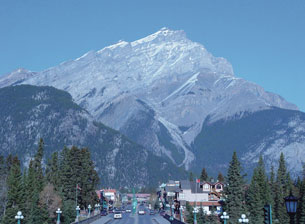
© Abstractx /Dreamstime
If you have been to Banff, you have probably seen elk wandering through yards and streets. You may have also heard stories of bears walking into town.
You may question who is interacting with whom. Are the bears interacting with the people or the elk?
Humans affect other populations of organisms within the national parks with the development of housing and shopping areas, their lifestyle choices, and their travels. In light of this, should there be more public access to remote wilderness areas? Should there be more housing and resorts built within the national parks? With your teacher or classmates, discuss the advantages and disadvantages of development in the national parks.
What is your opinion about increasing development within the national parks?
Prepare your statement and post it in the discussion area.
 Reflect on the Big Picture
Reflect on the Big Picture
You will now begin to work on the Module Project. You will continue to work on it in other lessons in this module. For this part, you will be creating an advertisement. Save your work for the advertisement into your course folder so it is readily available for future work on the project.
In the Big Picture for this module you were asked to think about what makes a vacation spot unique and to identify how vacationers may affect ecosystems they visit. Well-studied distinct ecosystems in Alberta are national parks, which are prime vacation destinations.
Now you will integrate what you know about the interactions of biotic and abiotic components of an ecosystem. You will apply this information to the concept of maintaining ecological integrity.
Ecological integrity exists when human activity doesn’t interfere with the structure and function of an ecosystem. In other words, the stressors present in an ecosystem are manageable. The ecosystem will adapt and continue to coexist alongside human activity without being drastically altered.
Parks Canada Ecological Integrity Advertisement
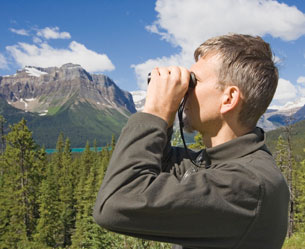
© Ulrike Hammerich/iStockphoto
Parks Canada constantly monitors ecosystem changes in order to maintain and restore ecological integrity. Your task is to develop a public-awareness advertisement describing the work Parks Canada does to maintain ecological integrity in national parks. The following six questions should be answered in your advertisement:
-
In your own words, what does ecological integrity mean to you?
-
Why is ecological integrity important in national parks?
-
What are some stressors affecting ecological integrity? Describe how humans are directly and indirectly causing many of these stresses.
-
How does Parks Canada monitor ecological integrity?
-
How does Parks Canada maintain ecological integrity?
-
How does Parks Canada draw on the traditional knowledge of First Peoples and integrate this knowledge into the management of park ecosystems?
Your advertisement may be in any of the following forms:
-
a television advertisement (PowerPoint presentation)
- a radio advertisement (recorded on tape, computer, or a printed transcript)
-
a poster
- a brochure
-
any other form approved by your teacher
You are creating an advertisement and will need to keep your message short and to the point. The television or radio advertisement should be no longer then 60 seconds. Read over the rubric to make sure your advertisement meets all the necessary criteria.
The Parks Canada Website on Ecosystem Management will provide most of the information needed for your advertisement.
To get to this website, perform a search by entering the keywords “parks Canada” into a search engine. Once at the Parks Canada website, enter “ecosystem management” into the website search bar. You will know you have chosen the correct article if the navigation bar to the left contains headings such as the following: “Ecosystem Principles” and “Ecosystem Restoration.”
You will be able to use the information from these web pages to begin creating your ad. You may need to perform other searches in the Parks Canada website to complete this assignment.
 Going Beyond
Going Beyond
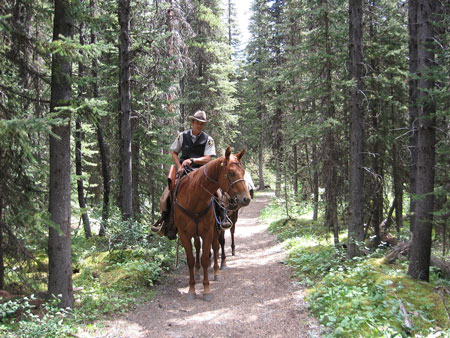
© D. Owens
Are you interested in helping Parks Canada maintain ecological integrity? Do you enjoy working outdoors? Maybe a career with Parks Canada interests you. Student summer jobs and careers are available. Are you qualified? Check out the Parks Canada website to learn more about the types of jobs available in ecology and what qualifications are needed.
 Module 3: Lesson 1 Assignment
Module 3: Lesson 1 Assignment
Remember to submit the Assignment answers to your teacher as part of your Module 3: Lesson 1 Assignment.
1.9. Page 7
Module 3—Ecosystems and Their Diversity
 Lesson Summary
Lesson Summary
In this lesson you explored the following question:
-
How do biologists describe the relationships that exist between species, populations, communities, and ecosystems?
The following terms are keywords in this lesson:
- species
- population
- community
- biotic
- abiotic
- ecosystem
- biosphere
- biome
It is important to know the definitions for these terms, but more importantly you should understand how these terms are related. You have learned about the relationships that exist between species—for example, the competition for food and habitat. The relationships between populations were explored—for example, predator-prey relationships. You should know how populations are affected by the biotic and abiotic components in their environment and how these components create different ecosystems and biomes.
Human populations affect most other organism populations in one way or another. Roads, houses, and human populations have moved into most of the world’s ecosystems, including the national parks and tropical islands. In order to protect these natural environments, it is important to understand the ecological relationships that exist.
Lesson Glossary
biodiversity: the variety of species in an area and their range of behavioural, ecological, physiological, and other adaptations
biome: an ecosystem or group of ecosystems in a specific region on Earth that has a particular combination of biotic and abiotic factors
community: all the individuals in all the interacting populations in a given area
ecosystem: a community of populations together with the abiotic factors that surround and affect the ecosystem
morphology: the form and structure of an organism or any of its part
population: a group of individuals of the same species living in a specific area at the same time
species: organisms that are similar in appearance and behaviour and are able to breed with one another to produce fertile offspring
1.10. Lesson 2 Intro
Module 3—Ecosystems and Their Diversity
Lesson 2—Classifying and Naming Organisms
 Get Focused
Get Focused
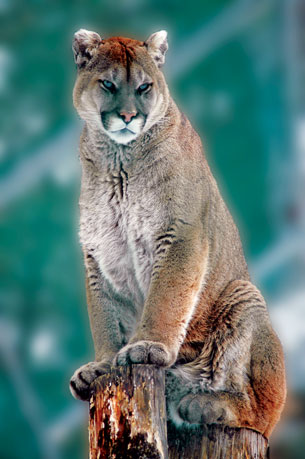
© Jan Daly/shutterstock
What would be the best way to describe this picture? Would you start with general observations and then move to specific observations? If this is how you would identify the organism in the picture, then you are using a valuable deductive reasoning skill. Deduction is used when scientists need to classify an organism all the way to its species name.
Imagine you are camping at the Two Jack Lake campground near Banff. The park warden has been warning hikers and campers about a mountain lion in the area. You overhear people at a nearby campsite describing their close encounter with a panther. Is this the same animal as a mountain lion, or is this a new danger?
Sometimes there can be confusion when talking about organisms by their common names. As a result, scientists have devised a system for naming organisms. You will learn more about classification and naming systems in this lesson.
In this lesson you will explore the following question:
-
How are organisms classified and named?
 Module 3: Lesson 2 Assignment
Module 3: Lesson 2 Assignment
Your teacher-marked Module 3: Lesson 2 Assignment requires you to submit a response to the following:
-
TR 2. Arthropod Activity
-
Discuss
You can access your Module 3: Lesson 2 Assignment. You can print off the assignment or save the download to your computer. Your answers can be saved on this document to your course folder.
You must decide what to do with the questions that are not marked by the teacher.
Remember that these questions provide you with the practice and feedback that you need to successfully complete this course. You should respond to all the questions and place those answers in your course folder.
1.11. Page 2
Module 3—Ecosystems and Their Diversity
 Explore
Explore
 Read
Read
Much like the periodic table of elements is universal to all scientists to identify the natural elements, biologists have developed rules of taxonomy that allow scientists to easily identify and communicate about species in an ecosystem.
taxonomy: the practice of classifying organisms based on common fundamental characteristics
domain: the highest level of classification of living things (above kingdom)
There is estimated to be somewhere between 10 and 100 million different species of organisms in the world. The field of taxonomy is the practice of classifying organisms. All organisms are classified into three domains. The three domains are Bacteria, Archaea, and Eukarya.
These rules of taxonomy are why a robin and a human are named differently. Different names are given to different organisms so that people are able to communicate better. If there wasn’t a name for a robin, it would take a long time to describe the type of bird sitting outside your window.
To learn more about the development of modern taxonomy practices, read pages 85 to 88 in your textbook.
 Self-Check
Self-Check
SC 1. Why are fungi not in the same kingdom as plants?
SC 2. What is the benefit for scientists to use binomial nomenclature rather than common names?
 Self-Check Answers
Self-Check Answers
SC 1. While fungi do not move, they lack chloroplasts and are not photosynthetic; they use digestive enzymes to break down food sources into absorbable molecules.
SC 2. Scientific names are universal, whereas a common name may be confusing and not the same in different regions. For example, panther, puma, and mountain lion all refer to the same species—Puma concolor.
 Watch and Listen
Watch and Listen
View the following animation to review the three-domain system of classification. The domain system is an evolutionary model of classification based on cell structure. This system proposes that a common ancestor cell gave rise to three different cell types, each representing a domain.
The three domains are the Archaea (archaebacteria), the Bacteria (eubacteria), and the Eukarya (eukaryotes). The Eukarya are then divided into four kingdoms: Protists, Fungi, Animalia, and Plantae. Organisms are placed into kingdoms depending on cell type, their ability to make food, and the number of cells in their body. For example, a daisy is classified as part of the Plantae kingdom because it is multicellular, it contains a nucleus, it contains a chloroplast that carries out photosynthesis, and the cells have a cell wall.
The following animation reviews the three-domain system of classification and introduces the six kingdoms.
Design a table to organize the kingdoms within their proper domains. Place this table in your course folder.
 Read
Read
Domains are subdivided into kingdoms. There are four kingdoms in the Eukarya domain: Protista, Fungi, Plantae, and Animalia. Each of these kingdoms is further subdivided into phyla, then class, order, family, genus, and species. Within each subdivision, the groups become more and more similar in physical characteristics and genetic makeup.
The following mnemonic table may help you remember the order of the subdivisions from domain to species.
Domain |
Danish |
Kingdom |
King |
Phylum |
Phillip |
Class |
Came |
Order |
Over |
Family |
For |
Genus |
Green |
Species |
Spinach |
 Try This
Try This
TR 1. In this self-marking quiz, drag and drop the categories in hierarchical order, beginning with domain.
TR 2. Arthropod Activity
Insects belong to the kingdom Animalia, the phylum Arthropoda, and the class Insecta. About one million species of insects have been classified, and there are probably several times that number still to be named.
morphological: having to do with the form and structure of an organism
The phylum Arthropoda not only contains insects but also contains organisms like lobsters, spiders, scorpions, and centipedes. Two out of three living things on Earth belong to the phylum Arthropoda. In the following activity you will use organisms’ anatomical or morphological characteristics to categorize arthropods into the different classes.
![]() Open the Classifying Arthropods activity and classify the four arthropods available on the table. Follow the procedures found along the left side of the screen. Use the table at the bottom of the animation to record your observations. This table can be found in your Module 3: Lesson 2 Assignment. Record your observations in the table, and complete the related questions.
Open the Classifying Arthropods activity and classify the four arthropods available on the table. Follow the procedures found along the left side of the screen. Use the table at the bottom of the animation to record your observations. This table can be found in your Module 3: Lesson 2 Assignment. Record your observations in the table, and complete the related questions.
1.12. Page 3
Module 3—Ecosystems and Their Diversity
 Read
Read
binomial nomenclature: a system in which a two-word name (genus and species) is used to identify an organism
Reread the section about binomial nomenclature on page 88 of your textbook.
The binomial nomenclature system gives every species a specific two-part scientific name.
 Self-Check
Self-Check
SC 3. Scientific names are in Latin. Why?
 Self-Check Answer
Self-Check Answer
SC 3. Latin is used for scientific names because it is not generally spoken by people in any country and is considered a "dead language" (not evolving), so the meanings of words will remain constant.
When forming an organism’s scientific name, remember that the genus is the first word (capitalized first letter) and the species name is the second word (lowercase first letter) of the two-part name (e.g., Homo sapiens).
scientific name: the genus and species name used together to identify an organism
In the following table you will notice that humans and the American robin are in the same domain, kingdom, and phylum but are in different classes. The scientific name for each is listed. You will noticed that it is made up of two names and written in italics—Genus species.
Two organisms are more closely related if they have more similarities in their classification.

© Yuri Arcurs/shutterstock
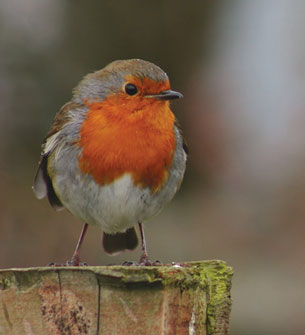
© Mark Simms/shutterstock
Human and Robin Classification |
||
|
Human |
American Robin |
Domain |
Eukarya |
Eukarya |
Kingdom |
Animalia |
Animalia |
Phylum |
Chordata |
Chordata |
Class |
Mammalia |
Aves |
Order |
Primates |
Passeriformes |
Family |
Hominidae |
Turdidae |
Genus |
Homo |
Turdus |
Species |
sapiens |
migratorius |
Scientific Name |
Homo sapiens |
Turdus migratorius |
 Watch and Listen
Watch and Listen
The animation that follows shows several species, their common names, and their scientific names. Note how the scientific name of an organism can describe its characteristics or where it lives.
Make a list of the characteristics that a robin and a human share for each classification level. List the characteristics they don’t share for the classification level at which they begin to be different. Place this list in your course folder for future reference.
Species Animation
1.13. Page 4
Module 3—Ecosystems and Their Diversity
 Reflect and Connect
Reflect and Connect
As you have seen, scientists have created a classification system that orders organisms on a broad spectrum. Through a series of observations, organisms can be identified as a species. You were introduced to the mnemonic device “Danish King Phillip Came Over For Green Spinach.” Mnemonic devices can be a useful tool for you to use in the future.
Create your own mnemonic to help you remember the order of the levels of classification.
 Self-Check
Self-Check
SC 4. Complete this Self-Check.
 Discuss
Discuss
How does the taxonomic classification system in Lesson 2 compare to the classification system in Lesson 1 (biosphere, biome, ecosystem, community, population, species)? How does this taxonomic naming system compare to other classification systems that libraries or chemists use? What are the purposes of other taxonomy systems?
Share your thoughts in the discussion area with your classmates. Review at least two student postings and reconsider your posting if required. Submit your final discussion posting in your Module 3: Lesson 2 Assignment.
 Reflect on the Big Picture
Reflect on the Big Picture
Parks Canada is responsible for ensuring proper ecological management of Canada’s national parks. This is critical as the popularity and numbers of visitors increase the pressures on these ecosystems.

© 2007 Jupiterimages Corporation
In Lesson 1 you discovered that maintaining ecological integrity is a priority for ecologists working in Canada’s national parks. Inventories of species present in each park are created and shared with other ecologists across the country. In this Reflect on the Big Picture, you will complete another component of your module project by examining inventory, monitoring, and researching programs at Waterton Lakes National Park. You will find this information by accessing the Parks Canada website and using these search terms: “parks Canada waterton lakes.” Once on the Waterton Lakes information page, use the navigation index to the left and choose “Park Management.”
Module Project—Parks Canada Ecological Integrity Advertisement
Add information collected from the Parks Canada website to your Ecological Integrity Advertisement.
Include information about at least one research program occurring in a national park. The following questions should be answered in the presentation:
- What research is being done and why?
- How does the common naming system (binomial nomenclature) help with this research?
Add this information to your course folder for use in the final module assessment.
 Module 3: Lesson 2 Assignment
Module 3: Lesson 2 Assignment
Remember to submit the Assignment answers to your teacher as part of your Module 3: Lesson 2 Assignment.
1.14. Page 5
Module 3—Ecosystems and Their Diversity
 Lesson Summary
Lesson Summary
In this lesson you explored the following question:
-
How are organisms classified and named?
In order to study and discuss ecosystems, you must know how to classify and name species. This lesson has shown the importance of taxonomy (classifying organisms) and binomial nomenclature (naming organisms). When scientists around the world study an organism, they will all use the same scientific name to describe the same species. This allows for collaboration between different national parks around the world. As you saw in Get Focused, animals can have more than one common name, which can create confusion.
Organisms are first organized into domains and kingdoms. The characteristics used to classify living things into the three domains and their kingdoms are based on cell structure, function, and number of cells (unicellular or multicellular). You were able to organize arthropod specimens into their classes based on their observed characteristics. Being able to classify organisms is important so that confusion can be avoided in determining names for the millions of organisms that occupy the planet.
Lesson Glossary
binomial nomenclature: a system in which a two-word name (genus and species) is used to identify an organism
domain: the highest level of classification of living things (above kingdom)
morphological: having to do with the form and structure of an organism
scientific name: the genus and species name used together to identify an organism
taxonomy: the practice of classifying organisms based on common fundamental characteristics
1.15. Lesson 3 Intro
Module 3—Ecosystems and Their Diversity
Lesson 3—Classifying and Naming Organisms: Dichotomous Keys

© Anette Linnea Rasmussen/shutterstock
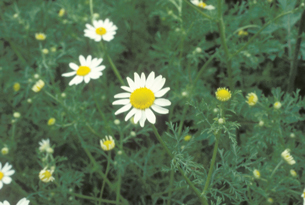
© Theodore Webster, USDA Agricultural Research Service, Bugwood.org
 Get Focused
Get Focused
If you are packing for a trip and someone tells you to pack your shoes, you might experience some confusion, especially if you are a slave to fashion. Did the person mean your Puma track shoes, your Aldo sandals, your Northface hiking boots, or your Nike runners? Each of these brands has specific observable characteristics (logos) that categorize it.
Parks Canada employees must similarly be able to distinguish between different organisms based on observations. For example, you may know that no wildflowers are to be picked in the parks; however, Parks personnel can sometimes be seen pulling flowers in ditches. They must know something you don’t. How do they make the decision about which flowers to pull? What observable differences do you see between the two photos here?
In this lesson you will explore the following question:
-
How can observable characteristics be used to identify organisms at the genus species level?
 Module 3: Lesson 3 Assignment
Module 3: Lesson 3 Assignment
Your teacher-marked Module 3: Lesson 3 Assignment requires you to submit a response to the following:
-
TR 2. Creating a Dichotomous Key
You can access your Module 3: Lesson 3 Assignment. You can print off the assignment or save the download to your computer. Your answers can be saved on this document to your course folder.
You must decide what to do with the questions that are not marked by the teacher.
Remember that these questions provide you with the practice and feedback that you need to successfully complete this course. You should respond to all the questions and place those answers in your course folder.
1.16. Page 2
Module 3—Ecosystems and Their Diversity
 Read
Read
morphology: the physical structure and form of an organism; the outward appearance of an organism
dichotomous key: an identification key that uses a series of paired comparisons to sort organisms into smaller and smaller groups
From your work in Lesson 2, you should be able to classify organisms into their domains and kingdoms based on cellular characteristics. In this lesson you will learn to use characteristics based on morphology to identify organisms.
Read page 89 in your textbook, and look at the structure of “Table 3.2.” This key will help you to make more specific classifications of an organism based on observable characteristics.
One way to identify different species is to use a dichotomous key. A dichotomous key is a series of yes and no questions that lead to the identification of a species. Questions in a dichotomous key refer to observable characteristics that can be used to identify an organism at the genus species level. This is the italicized Latin name that is recognized by scientists worldwide.
 Try This
Try This
TR 1. Dichotomous keys can also be created in an electronic format. Try using the following examples for practice and to see how dichotomous keys are structured. The next Try This question will require you to create your own dichotomous key.
Use an electronic dichotomous key to identify Alberta wildflowers. The animation uses the flower colour and structure to classify the wildflowers. Try identifying four different flowers. You have correctly identified the flower if you receive a ![]() .
.
Now try identifying plants with dichotomous keys by using another website. To find this web activity, type the keywords “world web wonders dichotomous key” into a search engine. The first link that appears should be the link to the correct activity. If you wish, you may try other sites that you find in your search.
TR 2. Creating a Dichotomous Key
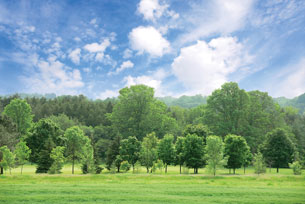
© Elena Elisseeva/shutterstock
In this activity you will be completing “Investigation 3.B: Creating a Dichotomous Key” on page 90 in the textbook. To give you an idea of how to create a dichotomous key, read the example page on “How to Make a Dichotomous Key for Shoes.”
![]() Proceed to Module 3: Lesson 3 Assignment to complete this activity.
Proceed to Module 3: Lesson 3 Assignment to complete this activity.
 Self-Check
Self-Check
SC 1. Answer question 5. a) and b) on page 92 of your textbook.
 Self-Check Answer
Self-Check Answer
SC 1.
- a) and b) Squirrel → Step 1a. → (Class Mammalia)
Tufted Puffin → Step 1b. → Step 2a. → (Class Aves)
Lamprey Eel → Step 1b. → Step 2b. → Step 3b. → (Class Agnatha)
Trout → Step 1b. → Step 2b. → Step 3a. →
Step 4a. → Step 5a. → Class Osteichthyes
Shark → Step 1b. → Step 2b. → Step 3a. →
Step 4a. → Step 5b. → Class Chondrichthyes
Snake → Step 1b. → Step 2b. → Step 3a. →
Step 4b. → Step 6a. → Class Reptilia
Frog → Step 1b. → Step 2b. → Step 3a. →
Step 4b. → Step 6b. → Class Amphibia
1.17. Page 3
Module 3—Ecosystems and Their Diversity
 Reflect and Connect
Reflect and Connect
You see the following plants and animals on your camping trip. What observable characteristics in the following pictures would help you to classify them?
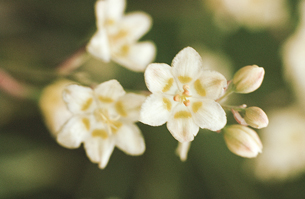
© 2008 Jupiterimages Corperation
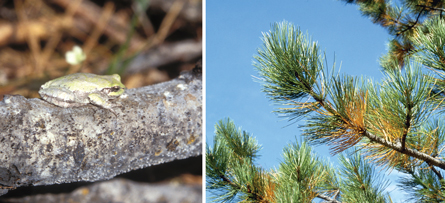
© Steven Katovich, USDA Forest Service, Bugwood.org (frog)
© William M. Ciesla, Forest Health Management International, Bugwood.org (tree)
Why is it important that Parks Canada employees be able to distinguish between species?
 Self-Check
Self-Check
SC 2. Complete this Self-Check.
 Reflect on the Big Picture
Reflect on the Big Picture
As a tourist in a new vacation spot, you will notice many things about your environment. You may take pictures of plants and animals, which might be the focus of your photos. The plants or animals may also be in the background. It’s the surrounding diversity that makes a vacation an experience to remember!
You may not pull out a dichotomous key on your vacation to identify something; however, you do look for recognizable characteristics that help you guess what kind of plants or animals you see. How does this help you to identify distinct ecosystems? Add your response to your course folder.
 Module 3: Lesson 3 Assignment
Module 3: Lesson 3 Assignment
Remember to submit the Assignment answers to your teacher as part of your Module 3: Lesson 3 Assignment.
1.18. Page 4
Module 3—Ecosystems and Their Diversity
 Lesson Summary
Lesson Summary
In this lesson you explored the following question:
-
How can observable characteristics be used to identify organisms at the genus species level?
By using and creating a dichotomous key, you were able to identify organisms using observation skills you already have. You have looked at what kind of characteristics separate species from one another. The traits you used to classify organisms in this lesson were morphological rather than cellular.
Lesson Glossary
dichotomous key: an identification key that uses a series of paired comparisons to sort organisms into smaller and smaller groups
morphology: the physical structure and form of an organism; the outward appearance of an organism
1.19. Lesson 4 Intro
Module 3—Ecosystem Diversity
Lesson 4—Studying Organisms in Ecosystems: Biomes, Habitats, and Niches
 Get Focused
Get Focused
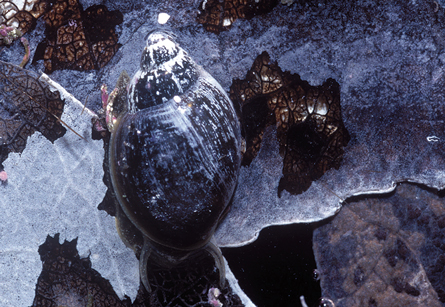
© Mark and Leslie Degner
On your next visit to Banff’s hot springs, look out for snails. Snails can be found in many different habitats, but these snails are unique. These snails are a different species than those you may find in Waterton Lakes National Park. How can that be? Isn’t a snail just a snail?
Different abiotic factors affect each park’s aquatic and terrestrial environments, creating different habitats for organisms in which to live. These different environments suit different species. Thermal springs are found in Banff National Park. This unique hot-water environment is the only place in the world where the Banff Springs Snail, Physella johnsoni, can be found. Unfortunately, this habitat is in danger, and the snail is on the endangered species list.
In this lesson you will explore the following essential questions:
- How do terrestrial and aquatic ecosystems support a diversity of organisms through a variety of habitats and niches?
- How do biotic and abiotic characteristics influence an aquatic and a terrestrial ecosystem?
 Module 3: Lesson 4 Assignment
Module 3: Lesson 4 Assignment
Your teacher-marked Module 3: Lesson 4 Assignment requires you to submit a response to the following:
- TR 1. Comparing Biomes and Niches Part A and B
- TR 2. Thought Lab 3.2: Forest Habitat and Bird Biodiversity
You can access your Module 3: Lesson 4 Assignment. You can print off the assignment or save the download to your computer. Your answers can be saved on this document in your course folder.
You must decide what to do with the questions that are not marked by the teacher.
Remember that these questions provide you with the practice and feedback that you need to successfully complete this course. You should respond to all the questions and place those answers in your course folder.
1.20. Page 2
Module 3—Ecosystem Diversity
 Explore
Explore
 Read
Read
In this lesson you will examine the effects of biotic and abiotic components on ecosystems. Abiotic factors determine where life exists and how it is distributed. Biotic components determine how an organism interacts with other organisms to ensure their survival. If you need to review biotic and abiotic factors, you can review the first chapter of your textbook.
Start Lesson 4 by reading “Climate and Biomes” on pages 93 to 95 of the textbook.
Abiotic factors cause weather conditions that are referred to as climate. The unequal heating of Earth’s atmosphere causes major climate zones and produces air and water currents that interact with physical features (mountains, islands, and lakes) to produce rainfall patterns. All of these and other factors create large areas with similar environmental conditions called biomes.
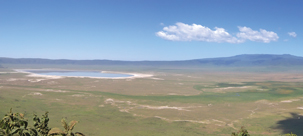
© POZZO DI BORGO Thomas/shutterstock
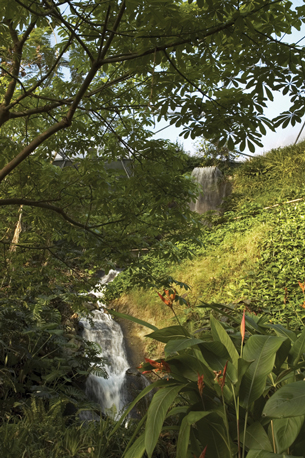
© Kevin Britland/shutterstock
climate: the average weather (taken over a long time period) for a particular region
biome: a regional group of distinctive plant and animal communities that are adapted to the region's physical environment
 Self-Check
Self-Check
SC 1. What is the relationship between temperature and precipitation and the abundance of life in a terrestrial biome?
SC 2. Why is there uneven heating of Earth?
SC 3. What other factors besides precipitation and rainfall determine abundance of photosynthetic organisms?
SC 4. There are transition zones between biomes. True or False.
 Self-Check Answers
Self-Check Answers
SC 1. The higher the temperature and the greater the amount of precipitation, the greater abundance of terrestrial life. Very high temperatures can inhibit growth.
SC 2. The Earth is spherical. Therefore, sunlight strikes Earth unevenly. The equator receives the most direct and intense light. As you move toward the poles, sunlight is spread over larger areas and is more diffuse.
SC 3. Topography, altitude, latitude, and temperature determine the types and abundance of photosynthetic organisms that can survive in a biome.
SC 4. True.
 Watch and Listen
Watch and Listen
Perform a web search to find videos or flash animations on a variety of biomes. You may use a variety of sources. Possible keywords include “teacher’s domain” and “Hippocampus.”
Use a chart to record the abiotic factors that help to create the characteristic climate in three different biomes. At least one biome should be aquatic.
 Self-Check
Self-Check
SC 5. Complete this Self-Check exercise about biomes.
 Read
Read
As you hike up Mt. Athabasca in Jasper National Park, you notice the temperature beginning to drop. There is a reason that taiga is the Russian word describing a cold mountain forest. As you climb, you encounter the taiga biome just as you would as you move from the equator toward the North Pole. The change in biomes as you increase in altitude is similar to the change in biomes that occurs as you increase in latitude toward the North Pole. This phenomenon is shown in the following diagram.
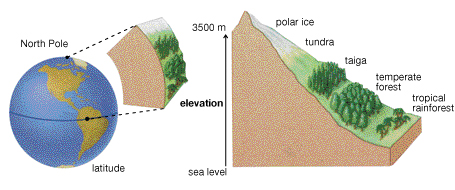
There are fewer living things the closer you get to the mountain summit. Fewer organisms are able to survive at the high altitude and low temperatures. The same decrease in the numbers of species occurs as you move from the equator to the North Pole. This is due to the decrease in average temperature and the decrease in the average precipitation that occurs as you move toward Earth's poles. The following graph shows that as you move closer to the equator in Central America, there are more species of mammals.
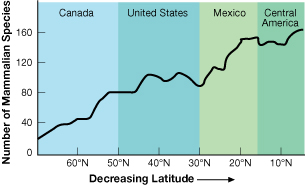
1.21. Page 3
Module 3—Ecosystem Diversity
 Explore
Explore
Scientists have divided the aquatic environments on Earth into two categories: marine and fresh water. Perform a websearch to find out information about aquatic biomes. Complete ONE of the following activities.
Choose six aquatic biomes that you discovered in your research in Watch and Listen. Identify each aquatic biome as either marine or fresh water, and find a picture or create a diagram to represent the biome. Organize this information using a visual organizer.
OR
List the five marine zones that you discovered in your research in Watch and Listen. Find pictures of species that would live in each of these zones. How have the organisms adapted to the specific abiotic factor in each zone? Organize this information using a visual organizer.
Share your information with other students by posting it in the discussion area.
 Read
Read
Starting on page 95 of the textbook, read the section called “Habitats.” Continue by reading about “Ecological Niche” and “Habitats and Niches within Ecosystems” on pages 97 and 98.
habitat: a place or area with a particular set of characteristics, both biotic and abiotic, in which an organism lives and can survive
range: a geographical area in which a population or species is found
niche: a place occupied by a species in its ecosystem and its role
All organisms require specific abiotic factors in order to survive. For example, most animals can’t survive if the temperature is above 45°C. But some bacteria are found living in hot springs with temperatures greater than 100°C. These required abiotic and biotic factors determine a species’ habitat. The location of these habitats will determine a species’ range. An organism living in its habitat has a role to play—it has certain biotic and abiotic needs in order to survive. This is called the organism’s niche.
 Self-Check
Self-Check
SC 6. How could you describe your niche?
SC 7. Why can many different organisms live in the same habitat?
SC 8. An observed species of animal has a very restricted diet; it eats only two types of plants. Explain why this species may have a higher probability of becoming endangered than a species that eats ten species of plants.
SC 9. Give an example of a niche in an aquatic ecosystem and a niche in a terrestrial ecosystem.
 Self-Check Answers
Self-Check Answers
SC 6. Your niche might be going to school, working part-time, looking after younger siblings, shopping for clothes, eating fruits and vegetables, or drinking water.
SC 7. Many organisms can share habitats because they have different niches.
SC 8. Because the animal’s niche (role and resource requirements) is smaller, it would be greatly affected by one or both food sources disappearing. It would have a limited range due to having a less diverse diet.
SC 9. A niche in an aquatic ecosystem could be the photosynthetic organisms which inhabit the surface of the water or animals that crawl on the bottom sediments. A niche in a terrestrial ecosystem could be spruce trees that grow in sandy soils—these trees provide food and habitats for different animals.
 Watch and Listen
Watch and Listen
As you watch the video titled “Survival of the Sea,” think about the ecological niche of the species in the marine ecosystem. What biotic and abiotic requirements do the species have? There are many species living in this same habitat, but each species has its own niche or role in the ecosystem. The niches may overlap but will not be the same. You will use this video to help answer Part B of Try This.
 Try This
Try This
TR 1. Comparing Biomes and Niches
Part A: Comparing Biomes
You will do this activity in the Module 3: Lesson 4 Assignment.
Part B: Comparing Niches
You will do this activity in the Module 3: Lesson 4 Assignment. The Assignment information is also included here to aid you in doing an Extension activity.
Select two species from the “Survival in the Sea” video. You will create a new Venn diagram to show the ecological niches of the two species. For parts of their niches that are similar, place the information in the area where the two circles overlap. Remember that an organism’s niche includes the following:
- the abiotic factors needed for survival (e.g., shelter, environment, temperature, salt/fresh water, pH, and rocks for camouflage)
- the biotic factors affecting its survival (e.g., predators and prey)
Extension: Can you fit a third species into your Venn diagram? Try.
Click below for a marking guide for the Venn diagram.
4 |
3 |
2 |
1 |
|
Alike Features |
identifies many ways the two are alike |
identifies several ways the two are alike |
identifies some ways the two are alike |
identifies a few or incorrect ways the two are alike |
Unique Features |
identifies many ways the two are different |
identifies several ways the two are different |
identifies some ways the two are different |
identifies a few or incorrect ways the two are different |
TR 2. Thought Lab 3.2: Forest Habitat and Bird Biodiversity
You will do this lab in the Module 3: Lesson 4 Assignment.
species richness: a number of species
abundance: a number of individual birds
stand: a group of forest trees of uniform species, composition, age, and health
Complete this Thought Lab, which is found on page 99 of the textbook. This study compares species richness and abundance in pure and mixed stands of trees. You will attempt to answer this question: How will communities of birds vary between a forest dominated by one tree species and a forest with a variety of tree species?
1.22. Page 4
Module 3—Ecosystem Diversity
 Reflect and Connect
Reflect and Connect
The beginning of this lesson showed you a picture of the Banff Springs Snail. This snail’s population is decreasing rapidly. Learn more about the biotic and abiotic factors affecting this snail’s population size and distribution. Perform a search on the Parks Canada website. Type in the keywords “Banff Springs Snail.”
What could you do to stop this snail from becoming extinct? What type of habitat does it need? What is its range? Put your findings in your course folder.
 Self-Check
Self-Check
SC 10. Complete this Self-Check exercise.
 Reflect on the Big Picture
Reflect on the Big Picture
As you vacation, do you have a niche? What is your habitat? What kind of biomes do you prefer to visit?
Place your response in the discussion area.
 Module 3: Lesson 4 Assignment
Module 3: Lesson 4 Assignment
Remember to submit the assignment answers to your teacher as part of your Module 3: Lesson 4 Assignment.
1.23. Page 5
Module 3—Ecosystem Diversity
 Lesson Summary
Lesson Summary
In this lesson you explored the following essential questions:
- How do terrestrial and aquatic ecosystems support a diversity of organisms through a variety of habitats and niches?
- How do biotic and abiotic characteristic influence an aquatic and a terrestrial ecosystem?
In this lesson you studied how abiotic factors influence climate and create areas (biomes) with a particular set of abiotic and biotic characteristics. Within these biomes are habitats that meet the specific biotic and abiotic needs of some organisms. The range of an organism is the geographical area where the organism is found in its habitat. Within an ecosystem, there are many habitats and niches that overlap. An animal’s niche is the interactions the animal has with the biotic and abiotic factors in its habitat. As you move on to Lesson 5, you will learn what limits population growth and range.
Lesson Glossary
abundance: a number of individual birds
biome: a regional group of distinctive plant and animal communities that are adapted to the region's physical environment
climate: the average weather (taken over a long time period) for a particular region
habitat: a place or area with a particular set of characteristics, both biotic and abiotic, in which an organism lives and can survive
niche: a place occupied by a species in its ecosystem and its role
range: a geographical area in which a population or species is found
species richness: a number of species
stand: a group of forest trees of uniform species, composition, age, and health
1.24. Lesson 5 Intro
Module 3—Ecosystem Diversity
Lesson 5—Studying Organisms in Ecosystems: Limiting Factors
 Get Focused
Get Focused

© Kiselev Andrey Valerevich/shutterstock
What factors limit what you can do when you are on vacation? Location? Weather? Resources? Parents? If you are at a campground or at a beach, what affects the tourist population? Does an influx of campers into one area affect other organism populations, or vice versa? How about when large numbers of frogs migrate into a favourite campground or a cougar claims the area?
Many factors limit where you can go and what you can do. Similar factors also limit many organism populations.
In this lesson you will explore the following question:
- How do limiting factors influence the distribution and range of organisms?
 Module 3: Lesson 5 Assignment
Module 3: Lesson 5 Assignment
Your teacher-marked Module 3: Lesson 5 Assignment requires you to submit a response to the following:
- TR 1. Limiting Factors: Part A and Part B
You can access your Module 3: Lesson 5 Assignment. You can print off the assignment or save the download to your computer. Your answers can be saved on this document to your course folder.
You must decide what to do with the questions that are not marked by the teacher.
Remember that these questions provide you with the practice and feedback that you need to successfully complete this course. You should respond to all the questions and place those answers in your course folder.
1.25. Page 2
Module 3—Ecosystem Diversity
 Explore
Explore
 Read
Read

© Gail Johnson/shutterstock (Arctic fox)
© iofoto/shutterstock (forest)
© Tree of Life/shutterstock (greenhouse)
In Lesson 4 you looked at how biotic and abiotic factors influence biomes, habitats, and niches. In Lesson 5 you will examine what biotic and abiotic factors limit growth in an ecosystem.
Living organisms have the ability to produce populations of infinite size if they are allowed to reproduce with infinite resources and space. Environments and resources, however, are finite. As a result, interactions between organisms are affected. Start Lesson 5 by reading “Factors Limiting Growth in Ecosystems,” “Abiotic Limiting Factors,” and “Biotic Limiting Factors” from page 98 of the textbook to page 103. At this time, you do not need to read “Thought Lab 3.2.”
 Self-Check
Self-Check
SC 1. Hypothesize why trembling aspen do not live everywhere in Canada.
SC 2. Why is unlimited growth impossible?
SC 3. What abiotic factors would limit the growth of greenhouse tomatoes?
SC 4. What biotic factors would cause population growth to slow down?
SC 5. Identify and explain the limiting effects of introducing Arctic foxes to the Aleutian Islands.
 Self-Check
Self-Check
SC 1. Here is one hypothesis: Trembling aspen do not live everywhere in Canada because they require certain growing conditions, which are dictated by abiotic factors.
SC 2. Populations can’t have sustainable long-term unlimited growth (short-term unlimited growth is possible). Limiting factors lessen the number of individuals of a population.
SC 3. Soil (nutrients), temperature, moisture, humidity, altitude, the amount of CO2, and the available solar energy would limit tomato growth.
SC 4. Population growth would slow because of competition within a species and between species. Predation and parasitism are other biotic factors that would slow down population growth.
SC 5. The predator-prey relationship between the Arctic foxes and the seabirds on the islands had a limiting effect. The introduction of the foxes “limited” the populations of seabirds almost to the point of extinction. The loss of the seabirds and their guano (seabird droppings) led to the loss of the grasslands and all the organisms that depended on the grassland habitat for survival.
 Watch and Listen
Watch and Listen
You will now watch an animation about regulating population size.
 Self-Check
Self-Check
SC 6. Complete this Self-Check exercise.
1.26. Page 3
Module 3—Ecosystem Diversity
 Read
Read
intraspecific competition: competition between members of the same populations (species) for a limited resource
exotic species: a species that is not native to an area and has been introduced, in most cases, by humans
introduced species: a species that is not native to an area and has been introduced, in most cases, by humans
interspecific competition: competition for limited resources among members of different species
Competition for resources—like food—will limit the size of any population. When there is no more food, members of the same species must compete for food. This will cause birth rates to decrease and death rates to increase, so the population decreases in size. This competition between members of the same species is called intraspecific competition.
Competition can occur between a native species and exotic species that have been introduced to an ecosystem. The introduction of exotic species or alien species is a problem around the world. Populations of exotic species can get out of control since these species do not have any natural predators or diseases to limit their populations. Some exotic species are introduced on purpose and others arrive by mistake. These introduced species can have a serious impact on the native ecosystem, since the introduced species may have a niche similar to the niche of a native species. This will cause competition. This is an example of interspecific competition, and this competition will limit the population size of the native species.
An Exotic Species Introduced to Australia
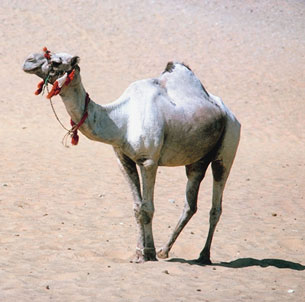
© 2007 Jupiterimages Corporation
Did you know that Australia has the largest population of wild camels in the world? In 2005 there were an estimated 700 000 camels roaming the continent. Camels were introduced to Australia between 1840 and 1907 as a way of opening up the desert outback. Camels helped build the rail and telegraph lines and also aided in supplying remote locations. Unfortunately, camels are now harming the native landscape and competing with cattle for vegetation.
Canada is not immune to the problem of exotic species. There are an estimated 800 species of exotic plant species living in the wild—this is roughly 16% of all the plants in Canada. Some of the exotic species of plants and animals in Canada include purple loosestrife, knapweed, zebra mussels, sea lampreys, and starlings.
 Self-Check
Self-Check
SC 7. Complete this Self-Check exercise.
 Try This
Try This
TR 1. Limiting Factors
![]() Answers to TR 1 questions will be placed in the Lesson 5 Assignment.
Answers to TR 1 questions will be placed in the Lesson 5 Assignment.
Part A: Limiting Factors Facing Burrowing Owls
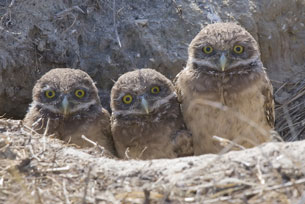
© Bob Blanchard/shutterstock
Read an article about the limiting factors facing burrowing owls. Create a table, a diagram, or a flow chart in the Assignment to list and explain how each biotic and abiotic limiting factor affects Alberta’s burrowing owl population. You will be assessed using the rubric provided.
4 |
3 |
2 |
1 |
|
Content Quality |
At least ten abiotic and biotic limiting factors are identified. |
From seven to nine abiotic and biotic limiting factors are identified. |
From four to six abiotic and biotic limiting factors are identified. |
Few or no limiting factors are identified. |
Organization |
The chart, diagram, or table is very logical, clear, and accurate. |
The chart, diagram, or table is mostly logical, clear, and accurate. |
The chart, diagram, or table is mostly accurate. |
The chart, diagram, or table is disorganized and inaccurate. |
Limiting Factors Effect on Burrowing Owls |
The effect of every limiting factor on the burrowing owl is explained. |
The effects of most limiting factors are explained. |
The effects of some limiting factors are explained. |
Few or no effects are explained. |
Part B: Knapweed—The Super Competitor
Weeds can become a limiting factor to other organisms when the weeds are introduced to a new environment.
- Investigate and write two paragraphs about the biology/ecology of spotted knapweed (Centaurea biebersteinii). Perform your own search to specifically answer these questions:
- How does spotted knapweed reproduce?
- What animals eat it?
- How was the plant introduced into North America?
- How does spotted knapweed spread?
- What problems does it cause in North American ecosystems?
- Why does spotted knapweed not cause the same damage to its native ecosystem?
Parks Canada may be a good website to explore.
5 |
4 |
3 |
2 |
1 |
|
| Questions Answered | All six questions are thoroughly and accurately answered. | All six questions are answered. |
Four to five questions are answered. |
Two to three questions are answered. |
One or no questions are answered. |
Answer the following questions using the graph provided.
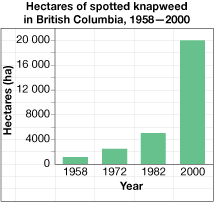
Graph Analysis
- Study the graph.
- Describe what has happened to the population of spotted knapweed since its arrival in British Columbia.
- Predict the number of hectares that will be covered by spotted knapweed in 2020. Explain your prediction.
- Explain why some introduced species can become so invasive and damaging to native species and ecosystems.
- Populations of spotted knapweed are present in Alberta. How could spotted knapweed spread throughout the province?
1.27. Page 4
Module 3—Ecosystem Diversity
 Read
Read
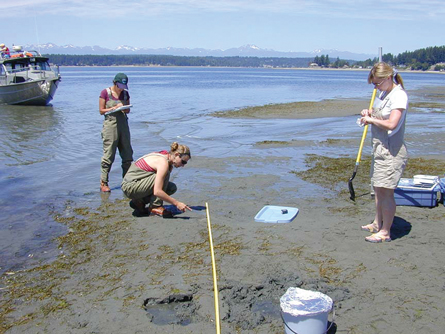
Photo courtesy U.S. Environmental Protection Agency, Region 10
How is the population of burrowing owls calculated? Can every single burrowing owl be counted? No, this counting would be very time consuming and expensive. Instead, samples are used to estimate the population size. Many different sampling techniques exist that can be used to estimate populations in ecosystems. Transects and quadrats are two techniques discussed in your textbook.
transect: a long, relatively narrow rectangular area marked out in a study area for the purpose of sampling a population
quadrat: an area of determined size that is marked out for the purpose of sampling a population

© Ken Canning/shutterstock
Read pages 105 and 106 in your textbook to learn about transects and quadrats.
Another commonly used method for estimating populations is the capture/recapture method. This method allows you to estimate the size of a population by catching a small sample, tagging them, and then releasing them. The next step is to recapture a sample of the population and count the number of tagged individuals in the new sample. You can then use this information to calculate the estimated total population size using the following formula.
![]()
Rearrange the formula to estimate the total population.
![]()
Here is an example of how this formula is used.
Estimating Population Size Example
There are a few problems/precautions associated with this method of collecting data:
- The tag on the organism may make it more difficult to hide from predators, or the tag may actually harm the organism.
- Enough time must be left for the tagged organisms to mix with the population before the second sample can be taken.
 Self-Check
Self-Check
SC 8. Complete this Self-Check exercise.
1.28. Page 5
Module 3—Ecosystem Diversity
 Reflect and Connect
Reflect and Connect
Create a visual—such as a poster or a diagram—to explain how limiting factors affect the distribution and range of humans. You can be either broad or specific. For example, you can look at how humans are distributed in the entire biosphere or how humans are distributed in an ecosystem or community.
OR
Explain how national parks are a factor in the distribution and range of organisms. The explanation may be audio, visual, or in written form.
Save this information to your course folder.
 Reflect on the Big Picture
Reflect on the Big Picture
This is the last component of your module project. You have also been working on this project in Lessons 1 and 2. The complete project can be found in the Module Assessment section of Module Summary and Assessment.
Being able to measure populations and identify factors that affect these populations helps Parks Canada try to maintain ecological integrity within the national parks. An effort is also made to balance tourism with ecosystem sustainability.
Module Project—Parks Canada Ecological Integrity Advertisement
It is time to complete the ecological integrity advertisement. Include information about the following two questions in your advertisement.
- What is the status of an endangered species found in Canada’s national parks, and what is being done to help prevent its extinction?
- What is an example of an exotic species found in Canada’s national parks?
Use the rubric to ensure you have completed all the components of this advertisement.
| 4 | 3 | 2 | 1 | 0 | |
|---|---|---|---|---|---|
| Questions Answered | All ten questions (six in Lesson 1, two in Lesson 2, and two in Lesson 5) are thoroughly and accurately answered in the presentation. | All ten questions are answered in the presentation. | From five to nine of the questions are answered in the presentation. | Three or four questions are answered in the presentation. | Fewer then three of the questions are answered in the presentation. |
| Presentation Quality | The presentation is clear, organized, and creative. |
The presentation is clear and organized. |
The presentation is understandable. |
The presentation is not clear or not organized. |
The presentation is not clear and is disorganized. |
 Going Beyond
Going Beyond
Explore another sampling technique that can be used to estimate population size. One technique uses DNA technology and hair from animals to predict population size. Explore this technique by using the activity simulation used to determine grizzly bear populations. Radio collars are another method used to track grizzlies, but the bears need to be caught and sedated. This method allows bear populations to be estimated without having direct contact with humans.
Follow the procedure found on the left side of the Virtual Lab. Record the data in the table, and answer the Analyze questions found at the bottom of the Lab.
Module 3: Lesson 5 Assignment
Remember to submit the Assignment answers to your teacher as part of your Module 3: Lesson 5 Assignment.
1.29. Page 6
Module 3—Ecosystem Diversity
 Lesson Summary
Lesson Summary
In this lesson you explored the following question:
-
How do limiting factors influence the distribution and range of organisms?
Limiting factors can be any biotic or abiotic factor that controls the size of a population. These factors can affect the population size and density. Population sizes can be estimated by taking small samples. It is important that ecologists know the populations of the species in the national parks. Without this knowledge, an ecologist would not be able to measure and maintain the ecological integrity of parks.
In Lesson 6 you will be using the information you have gathered from the last five lessons to prepare for and perform a field study.
Lesson Glossary
exotic species: a species that is not native to an area and has been introduced, in most cases, by humans
interspecific competition: competition for limited resources among members of different species
intraspecific competition: competition between members of the same populations (species) for a limited resource
introduced species: a species that is not native to an area and has been introduced, in most cases, by humans
quadrat: an area of determined size that is marked out for the purpose of sampling a population
transect: a long, relatively narrow rectangular area marked out in a study area for the purpose of sampling a population
1.30. Lesson 6 Intro
Module 3—Ecosystem Diversity
Lesson 6—Studying Organisms in Ecosystems: A Field Study
 Get Focused
Get Focused
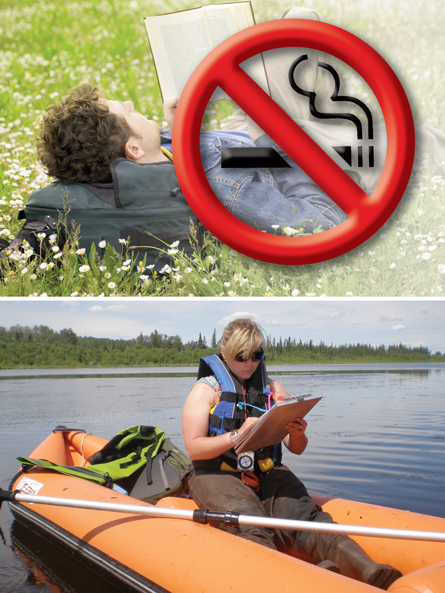
© Diego Cervo/shutterstock (top)
Up to this point, you have used your vacation experiences as a way to look at ecosystem diversity. What would happen if you were told to go on a mini-trip to the corner of a nearby park, field, or forest to perform a field study? Would you have the necessary knowledge to do a field study? Thinking back to previous lessons, what skills and concepts would help you to make the best observations of the ecosystem? What types of items will you need to notice and record?
In this lesson you will explore the following essential question:
- What can observations on biotic and abiotic factors gathered in a field study tell you about an ecosystem?
 Module 3: Lesson 6 Assignment
Module 3: Lesson 6 Assignment
Your teacher-marked Module 3: Lesson 6 Assignment requires you to submit a response to the following:
- TR 1. The Mountain Pine Beetle vs an Ecosystem
- TR 2. Planning for Your Field Study: Part I
- TR 3. Planning for Your Field Study: Part II
- LAB 1 OR Virtual LAB
You can access your Module 3: Lesson 6 Assignment. You can print off the assignment or save the download to your computer. Your answers can be saved on this document to your course folder.
You must decide what to do with the questions that are not marked by the teacher.
Remember that these questions provide you with the practice and feedback that you need to successfully complete this course. You should respond to all the questions and place those answers in your course folder.
1.31. Page 2
Module 3—Ecosystem Diversity
 Explore
Explore
 Read
Read
Earlier you were introduced to The Mountain Pine Beetle vs. An Ecosystem. What interactions have happened to make the forest ecosystem unhealthy in the southern interior of British Columbia? Read pages 76 and 77 of your textbook.
 Try This
Try This
TR 1. The Mountain Pine Beetle vs. an Ecosystem
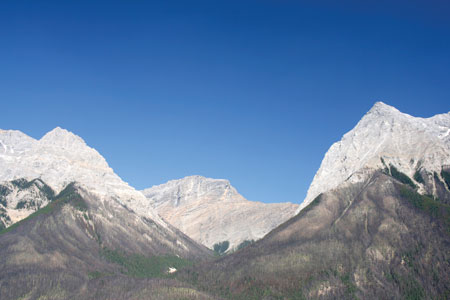
© Marek Slusarczyk/shutterstock
You will be answering the TR 1. questions in the Lesson 6 Assignment.
- In point form, with a chart or diagram format, respond to “Analysis” questions 1 to 3 on page 77 of the textbook.
- As an extension activity, write or present—as a podcast or a video—a short paragraph about how the pine beetle infestation affects you. Take the part of either a local elder or a logger.
 Read
Read
When staff at Alberta’s Ministry of Sustainable Resources Development wanted to monitor the mountain pine beetle in Alberta’s pine forests, they planned and carried out field studies. The final activity of this lesson will require you to take part in a field study that investigates and compares two ecosystems. Throughout this lesson you and/or your group will be preparing for your field study. The next Try This activity is designed to help you begin your preparations by considering individuals, populations, and communities within two ecosystems.
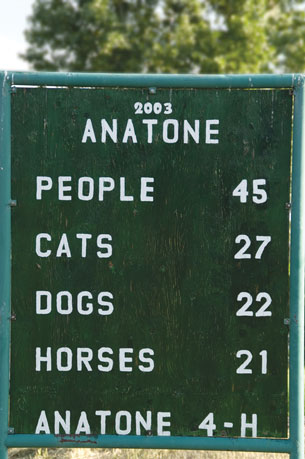
© Sue Smith/shutterstock
TR 2. Planning for Your Field Study: Part I
You may choose to participate in the field study on your own or in a group. If you decide to work in a group, the discussion area may be one way for you to communicate between your group members. You will be handing in Steps 5 and 6 of the Procedure to be marked as part of the Lesson 6 Assignment. When you hand in these two sections, please indicate what two ecosystems were chosen for your field study.
Procedure
Step 1: Read “Investigation 3.D” on page 106 of the textbook to familiarize yourself with what you will be doing in your field study.
Step 2: Brainstorm a list of possible local ecosystems that could be the focus of your field study. Recall that ecosystems can vary in size. Make sure that your list includes areas possible for you to access.
Step 3: Choose two ecosystems from your list. They should be similar types of ecosystems, but in different areas.
One example could be a small pond in a forested area vs. a nearby water-filled ditch.
Step 4: Decide how you will record, store, and organize information from your field study (charts, pen and paper, computer).
Step 5: Each member of the group (and those students working by themselves) must choose one species that lives in both ecosystems. Remember that species can be anything from one of the six kingdoms. You will write a paragraph to explain how this species interacts with the abiotic and biotic components of its environment. For example, what are its nutrient requirements? Your information will be based on experiences, observations, and/or research.
Step 6: Of the species you chose in step 5, describe the typical population, community, and ecosystem.
You may use drawings, charts, or a paragraph for your description.
1.32. Page 3
Module 3—Ecosystem Diversity
 Read
Read
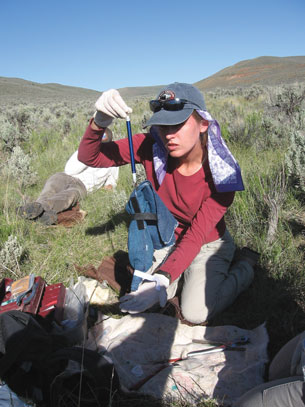
© Mikaela/shutterstock
In Lesson 1 you practised observing leaves from two different locations. You were observing and taking measurements of a biotic component of the environment. By forming hypotheses, you speculated on the relationship between biotic components and abiotic characteristics of the ecosystem. If you had to measure abiotic characteristics of the environment, such as air temperature or depth of light penetration in a pond, what tools would you use? In this next Try This activity, you and/or your group will select the tools you will need for your field study.
 Try This
Try This
TR 3. Planning for Your Field Study: Part II
Procedure
Step 1: Research some of the abiotic components of the ecosystem you will be investigating (climate, sunlight hours, average precipitation). You may use Internet and print resources.
Step 2: Decide which three abiotic features of your ecosystem you will measure. Brainstorm the types of tools you will need to measure these abiotic features. How would you measure soil or air temperature? You may want to contact a field biologist at a local university or a forestry department office to find out what tools they use to conduct a field study.
Step 3: Decide what tools you will use to help you detect and identify organisms found in your field study.
Step 4: Decide how you will record what you see and what data you will obtain.
Analysis
Step 1: What is the difference between precision and accuracy? (Hint: Refer to “Appendix A” on page 748 of your textbook.)
Step 2: How do the tools you use to gather information about an ecosystem affect the accuracy or precision of your measurements? For example how does gathering information about soil moisture content from an Internet database or map compare with completing the measurements yourself?
Step 3: What are two advantages of each tool?
Step 4: What are two disadvantages of each tool?
Step 5: Is it precise enough to measure an abiotic factor at only one location in an ecosystem? Explain your answer.
Step 6: How will you obtain the tools you have selected? Which members of your team will be responsible for using the various tools?
In the Lesson 6 Assignment, you will be assessed on Step 2 of the procedure and the six Analysis questions. Save your responses to these questions in your course folder.
1.33. Lab
Module 3—Ecosystem Diversity
 Lab
Lab
Up to this point, you have been preparing for “Investigation 3D.” However, you now have a choice of activities. This may be teacher directed or student directed. Because it is not always possible to obtain the necessary equipment or find suitable field study locations, there is also a Virtual Lab that you may choose to complete. The skills you have been practising up to this point are also applicable to this lab. If you were working in a group, you may continue to do so.
The virtual lab compares an aquatic ecosystem with a terrestrial ecosystem. Please read through this section even if you are choosing to do the virtual lab. The information below is applicable to the virtual lab.
Lab 1. Investigation 3D: An Ecosystem Field Study
You have been preparing for your field study throughout this lesson. In this investigation you will sample and compare study sites from the two similar ecosystems you chose in TR 2. You will use the tools you chose in TR 3 to help gather information about the biotic and abiotic components of these ecosystems. The purpose of this investigation is to
- observe and measure abiotic and biotic characteristics of ecosystems
- apply classification and binomial nomenclature to the species in your study
- analyze the interactions and connections of abiotic and biotic characteristics within your chosen ecosystems
- evaluate the accuracy and reliability of measuring instruments used and identify the degree of error
- work co-operatively and share data and ideas
Click here for the handout that will guide you through this investigation. You can print this document if needed. You may also refer to page 106 of the textbook. However, parts of the investigation have been modified. You are required to complete an experimental plan before you complete your field study and field report.
OR
Lab 1. A Virtual Field Study
If you are doing the Virtual Field Study, click for a description of what you will be required to do.
Once you have read/printed this document, you may proceed to the Virtual Field Study. You are required to complete an experimental plan before you complete your field study and field report.
Remember that you must submit the appropriate experimental plan and field report at the end of this Assignment. Both report formats are found in Module 3: Lesson 6 Assignment. You will be submitting a field study report for Investigation 3.D OR a report for the Virtual Field Study. You are not required to do both reports unless requested to do so by your teacher.
1.34. Page 5
Module 3—Ecosystem Diversity
 Reflect and Connect
Reflect and Connect
If you had to do another field study, what would you do to make sure your study was reliable? Record your response in your course folder. Remember you can make a podcast, write down your answer, or make a 20-second video with a digital camera.
 Reflect on the Big Picture
Reflect on the Big Picture
Will you look at a vacation spot in the same way? What skills do you now have that would allow you to identify a distinct ecosystem? Record your response to your course folder in your favourite format. Also post this response to the discussion area for others to view.
 Module 3: Lesson 6 Assignment
Module 3: Lesson 6 Assignment
Remember to submit the Assignment answers to your teacher as part of your Module 3: Lesson 6 Assignment.
1.35. Page 6
Module 3—Ecosystem Diversity
 Lesson Summary
Lesson Summary
In this lesson you explored the following essential question:
- What can observations on biotic and abiotic factors gathered in a field study tell you about an ecosystem?
In order to answer this question, you had to conduct a field study. Once you chose what ecosystems to study, you had to choose tools that would help you gather information about the ecosystems. It was important to distinguish between accuracy and precision. You also had to identify dominant species in your ecosystems and explain their niches. After you had planned and carried out your field study, you were required to submit a field report. You may have chosen to make your observations via the virtual lab or by heading out into the “field.” In your field report you analyzed your information and made conclusions about the health of your ecosystems based on your field study observations.
1.36. Module Summary/Assessment
Module 3—Ecosystem Diversity
 Module Summary
Module Summary
Canada’s national parks are treasures that need to be preserved for future generations to enjoy. To maintain the biodiversity of the parks, people must understand what important interactions occur in the ecosystems. The more you know and understand about these interactions, the greater will be your ability to preserve them.
You have learned that ecosystems contain many different species of organisms. These organisms are considered to be species if they can reproduce and produce viable offspring. Some other terms discussed were population and communities. A population is a group of one type of species living in an area, and communities are made up of many different populations.
You have also learned that ecosystems contain many different communities, populations, and abiotic components that all interact. The interactions an organism has with its biotic and abiotic environment make up its niche and determine the organism’s distribution and habitat requirements. Scientists organize all of the biotic components into one of three domains—bacteria, archaea, and eukarya. Species within each of these domains can be further classified into a kingdom, then a phylum, class, order, family, genus, and species. Species scientific names are made up of the genus and species name and are unique to each species. Dichotomous keys help people identify and name unknown species.
In this module you have learned about the relationships occurring between the biotic and abiotic components of ecosystems. Each living thing is dependent on its non-living environment for survival. The protection of this environment is one of the key aspects of maintaining biodiversity. In Module 4 you will again look at populations and examine how their interactions with the biotic and abiotic environment can cause the populations to change over time.
 Module Assessment
Module Assessment
In this module you will develop a public-awareness advertisement to educate the general public about the work Parks Canada does to maintain the diversity of organisms within Canada’s national parks. Read the following project description. Do not begin this project until instructed to do so in Lesson 1.
Parks Canada Ecological Integrity Advertisement
Parks Canada constantly monitors ecosystem changes in order to maintain and restore ecological integrity. Your task is to develop a public-awareness advertisement describing the work Parks Canada does to maintain ecological integrity in national parks. The following questions should be answered in your advertisement:
- In your own words, what does ecological integrity mean to you?
- Why is ecological integrity important in national parks?
- What are some stressors affecting ecological integrity? Describe how humans are directly and indirectly causing many of these stresses.
- How does Parks Canada monitor ecological integrity?
- How does Parks Canada maintain ecological integrity?
- Does Parks Canada draw on the traditional knowledge of First Peoples and integrate this knowledge into the management of park ecosystems?
- What is the status of an endangered species found in Canada’s national parks, and what is being done to help prevent its extinction?
- What is an example of an exotic species found in Canada’s national parks?
- What research is being done and why? (One research program occurring in a national park should be explained.)
- How does the common naming system (binomial nomenclature) help with this research?
Your advertisement may be in any of the following forms:
- a television advertisement (PowerPoint presentation)
- a radio advertisement (recorded on tape, computer, or a printed transcript)
- a poster
- a brochure
- any other form approved by your teacher
You are creating an advertisement and will need to keep your message short and to the point. The television or radio advertisement should be no longer then 60 seconds. Read over the rubric to make sure your advertisement meets all the necessary criteria.
Place each part of the presentation into your learning portfolio. You will add to it in each of Lessons 1, 2, and 5.
The Parks Canada Website on Ecosystem Management will provide most of the information needed for your advertisement.
To get to this website, perform a search by entering the keywords “parks Canada” into a search engine. Once at the Parks Canada website, enter “ecosystem management” into the website search bar. You will know you have chosen the correct article if the navigation bar to the left contains headings such as “Ecosystem Principles” and “Ecosystem Restoration.”
You will be able to use the information from these web pages to begin creating your ad. You may need to perform other searches in the Parks Canada website to complete this assessment.
4 |
3 |
2 |
1 |
0 |
|
| Questions Answered | All ten questions (six in Lesson 1, two in Lesson 2, and two in Lesson 5) are thoroughly and accurately answered in the presentation. |
All ten questions are answered in the presentation. |
From five to nine of the questions are answered in the presentation. |
Three or four questions are answered in the presentation. |
Fewer then three of the questions are answered in the presentation. |
| Presentation Quality | The presentation is clear, organized, and creative. |
The presentation is clear and organized. |
The presentation is understandable. |
The presentation is not clear or not organized. |
The presentation is not clear and is disorganized. |
1.37. Module Glossary
Module 3—Energy Flow and the Cycling of Matter
Module Glossary
acid deposition: the deposit of acid to land and water through acidic rain, snow, or sleet
adhesion: the tendency of unlike molecules to cling together because of attractive forces
Water is adhesive also due to polarity—the negative and positively charged molecules in water attract other ionic molecules.
biodiversity: a variety in the number and kind of species in a given area
biogeochemical cycle: a diagram representing the movement of elements and compounds between living and non-living components of an ecosystem
biomagnification: the buildup of harmful chemicals in higher trophic levels (top predators)
biosphere: all areas on Earth that can sustain life and are inhabited by organisms (air, water, land)
carbon sink: a system that removes more carbon dioxide from the atmosphere than it releases into the atmosphere
chemosynthesis: the process by which certain fungi and bacteria use the energy from chemical nutrients to chemically convert carbon (inorganic) into carbohydrates (organic)
cohesion: inter-molecular attraction between like-molecules of a substance
Water is strongly cohesive due to the polarity of its molecules.
conservationist: someone who advocates saving and/or conserving natural resources
consumers: organisms that must obtain their food (energy) by eating other organisms (producers or consumers); also called heterotrophs
denitrification: the process of converting nitrates in the soil into nitrogen gas
denitrifying bacteria: a type of soil bacteria that converts nitrates in soil into nitrogen gas, releasing this gas to the atmosphere
ecological footprint: an analysis of human consumption of natural resources compared to the ability of Earth to recreate them
This analysis gives an estimate of the area (hectares) required for humans to live based on their given lifestyles—most North American lifestyles are not currently sustainable according to the analyses.
equilibrium: all living components of the biosphere (e.g., humans, bacteria, plants) balance in a system; the overall fluctuations in the system balance out and there is no net change over time
eutrophication: excessive plant growth and decay caused by an excessive amount of chemical nutrients
first law of thermodynamics: energy in a system cannot be created nor destroyed; it changes forms
food chain: a diagram or model that uses a straight line to show how food (energy) transfers from producers to primary consumers to higher trophic levels
food web: a diagram or model that shows the connections among food chains (food/energy transfer) in an ecosystem
heat capacity: the amount of heat energy (J) required to change the temperature of one gram of substance by 1°C
Water has a high heat capacity of 4.19 J/g°C.
limiting factor: any biotic or abiotic factor that controls or limits the functioning of an organism
nitrification: the process of converting ammonia into nitrates or nitrites
nitrifying bacteria: a type of soil bacteria that converts ammonia into nitrates and nitrites
nitrogen fixation: the process of converting nitrogen gas into ammonia
peat: deep layers of mosses and plant remains unable to completely decompose due to the lack of oxygen in water-saturated soil
photoautotrophs: photosynthetic producers
photosynthesis: the process by which plants, algae, and some kinds of bacteria use solar energy to chemically convert carbon (inorganic) into carbohydrates (organic) such as sugars and starches
producers: organisms that are able to produce their own food (energy) by harnessing chemical or solar energy; also called autotrophs
trophic level: describes the feeding level through which matter and energy are transferred; indicates an organism’s position in the food chain (e.g., producer, primary consumer, secondary consumer)